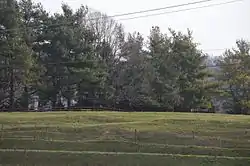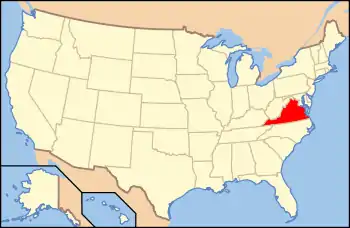Madison Farm Historic and Archeological District
The Madison Farm Historic and Archeological District is a complex of historic and prehistoric Native American and colonial sites in rural Montgomery County, Virginia. It is located in and near the flood plains of the South Fork of the Roanoke River, and covers 115 acres (47 ha). Its historic artifacts include a surviving hall-parlor log house, probably built late in the 18th century by William Madison, which is one of the few of its type to survive in the county. The building was substantially modified in the 19th century, refinishing the interior and adding a two-story porch. The farm site includes a number of historic outbuildings (or remnants of same), and is a good prospect for archaeological investigation into period farming practices.[2]
Madison Farm Historic and Archeological District | |
 | |
  | |
| Nearest city | Elliston, Virginia |
|---|---|
| Area | 115 acres (47 ha) |
| Architectural style | Hall-parlor plan |
| MPS | Montgomery County MPS |
| NRHP reference No. | 90002190[1] |
| Added to NRHP | January 25, 1991 |
The farm is also the site of two prehistoric Native American sites. One, designated 44MY37 and known as the Marye Site, is a significant Late Woodland Period village site, at which evidence of Archaic period occupation has also been found. Investigation of this site is believed to be important in yielding further understanding of Native American life in the area.[2]
The district was listed on the National Register of Historic Places in 1991.[1]
References
- "National Register Information System". National Register of Historic Places. National Park Service. July 9, 2010.
- "Multiple Property Submission for Prehistoric and Historic Resources of Montgomery County, Virginia". National Park Service. Retrieved 2014-04-12.

